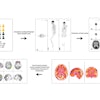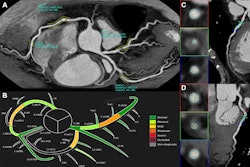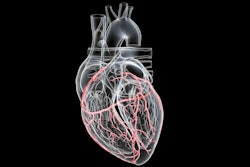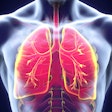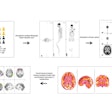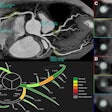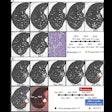An AI model based on cardiac CT angiography (CCTA) shows differences in plaque volume among chest pain patients, according to research presented July 18 at the Society of Cardiovascular Computed Tomography annual meeting in Montreal, Canada.
In his presentation, Beshoy Iskander, MD, from Harbor-UCLA Medical Center in Torrance, CA, discussed his team’s findings showing the success of the model. It showed that chest pain patients with midlevel coronary artery calcium score had a higher volume of noncalcified plaque (NCP) than asymptomatic patients.
Assessing NCP volume in patients can help stratify risk and influence further proper preventive therapies. Medical specialties continue to explore ways that AI can help improve precision and address diagnostic challenges.
Iskander and colleagues studied differences in NCP volume between symptomatic and asymptomatic patients with similar risk factors. Their AI model used CCTA data to quantify plaque in patients with chest pain.
Final analysis included 1,835 participants who underwent CCTA and quantitative plaque analysis between 2020 and 2024. The researchers reported low-density, noncalcified, calcified, and total plaque volume by using automated plaque analysis software (Cleerly) by the following clinical coronary artery calcium (CAC) categories: 0, 1 to 99, 100 to 299, 300 to 1,000, and 1,000-plus.
Of the total participants, 86% reported no chest pain while the remaining 14% did. Those who reported chest pain were younger (age 63.2 vs. 65.7).
Most subjects reported no chest pain (86%), while 14% reported chest pain. Subjects reporting chest pain were significantly younger (age 63.2 vs. 65.7) and had significantly lower systolic blood pressure.
The team found that the following factors were not significantly different between participants with and without chest pain: statin therapy use, hypertension, and prevalence of diabetes mellitus.
And low-density, noncalcified, calcified, and total plaque volume by clinical CAC category did not achieve statistical significance between participants with or without chest pain.
Finally, participants with CAC levels between 100 and 300 and who reported chest pain had significantly higher noncalcified plaque volume versus those with no angina (152.3 vs. 108.9, p = 0.035).
Iskander said that accounting for symptoms "can have implications when risk-stratifying and treating patients with similar CAC scores."




